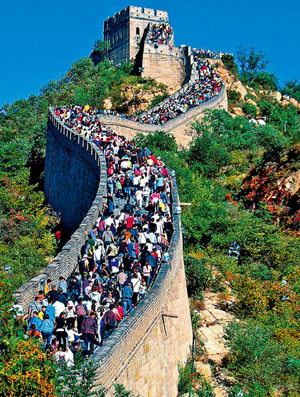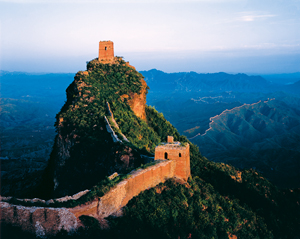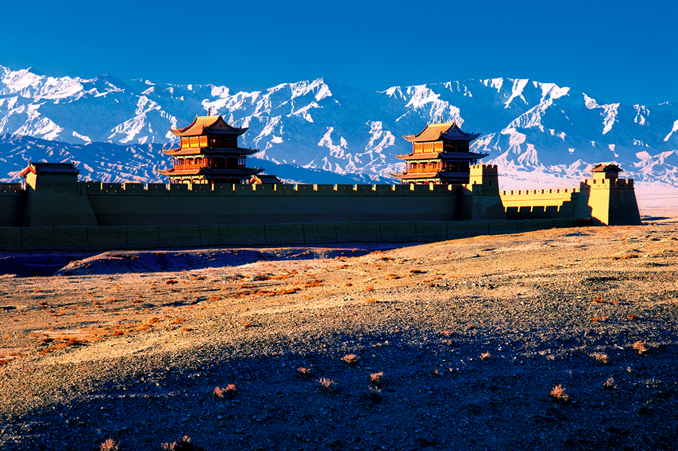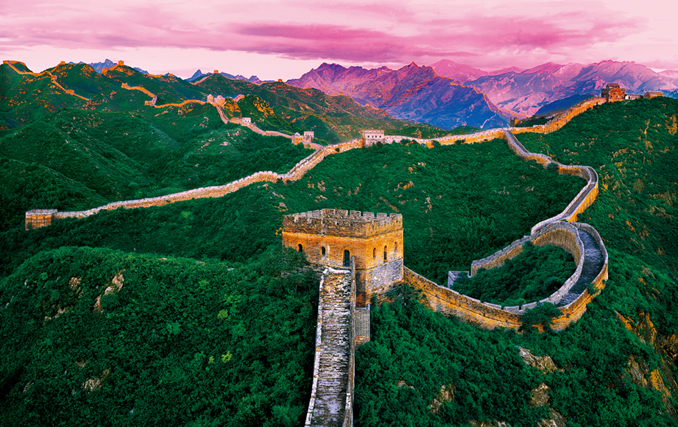The Great Wall
As many see it, the Great Wall is the symbol of the Chinese nation.
The Great Wall was not built in a day. It is great in terms of both distance and time. More than 10 dynasties were involved in building and rebuilding the Great Wall from the 7th century BC to the 17th century AD. The different sections of the Great Wall were built in different dynasties, and are different in length and location. Therefore, if one wants to know how long the Great Wall is, one must tell which dynasty one is referring to.
 |
| Tourists at the Badaling section of the Great Wall |
The Great Wall as we see it today is basically the wall rebuilt or renovated in the Ming Dynasty (1368-1644). Renovation of the old Great Wall started almost immediately after the dynasty was established and the project lasted until 1600, 44 years before it collapsed. The Great Wall of the Ming Dynasty starts at Mt. Hushan of eastern Liaoning Province in the east and ends at Jiayuguan Pass in Gansu Provwest, snaking through Liaoning, Hebei, Tianjin?Beijing, Shanxi, Inner Mongolia, Shaanxi, Ningxia and Gansu provinces, with a total length of 6,700 km. The project was also the last largest renovation of the Great Wall in history. The Great Wall of the Ming Dynasty is 400 km longer than China’s longest river, the Yangtze.
Ruins of the Great Wall built or renovated in other dynasties can still be seen in central and northern China. The earliest Great Wall was built in 656 BC - maybe even earlier in the State of Chu. Separate states tore apart the nation at that time as they fought wars with each other. The Great Wall of the Chu Kingdom was built for military defense and proved to be effective. Then other states started to build similar walls. The walls built by different states vary in length, ranging from a few hundred kilometers to one or two thousand.
All these walls failed to block the advance of armies of the Qin State. In the year 221 BC, Emperor Shihuang unified the country and established the Qin, China’s first feudal dynasty. For a time, those walls seemed no longer necessary. However, the nomadic Xiongnu ethnic group in the north often made incursions into the Qin territory. To defend the empire’s northern borders, Emperor Shihuang ordered a project to connect the defense walls in the north. That is how the Great Wall or the Great Wall of ten Thousand Li came into being, extending from east to west for well over 5,000 km.
The Qin Dynasty collapsed in 206 BC, and was succeeded by the Han, which was to rule China until 220 AD. Invasions by the Xiongnu horsemen became even more frequent and intense during the early period of the new dynasty, even though there was intermittent peace. ‘The moon of the Qin Dynasty still shines over the border passes of the Han, and soldiers are yet to return from battles fought ten thousand Li away.’ These lines from a Tang Dynasty poem say something about what happened in China during that period. As a result, the Great Wall was extended further towards the west and at the same time, an Outer Great Wall, beyond the sections of the Great Wall of the Qin Dynasty, was also built. That brought to 10,000 km the total length of what is broadly referred to as the Great Wall of China. The Great Wall was designed for defence and security purposes. In practice, however, it provided protection to the newly developed Silk Road as well.
 |
| Watchtower atop the Simatai section of the Great Wall in Beijing |
Most ancient Chinese emperors were ethnic Hans. During the Northern and Southern Dynasties (420-589 A.D.), however, eight ethnic minority regimes ruled north China in succession. These regimes also built walls for defense. Wall building continued in the Liao Dynasty (916-1125 A.D.) and the Jin Dynasty (1115-1234 A.D.). Walls built in the Jin Dynasty were approximately 4,000 km long.
Scores of long walls were built in the various dynasties which are collectively called the Great Wall. Some were consolidated, some renovated, and others just deserted. For example, some sections of the Great Wall of the Ming Dynasty were shifted several hundred kilometers south from the north under good control. So, they never had their counterparts of the Qin Dynasty. Experts estimate that the Great Walls built in the past 2,000 years, if put together, can measure up to be as long as 50,000 km.
The building or renovation of the Great Wall was a time consuming project, and required an immeasurably huge input of human, financial and material resources. Some walls with topography of strategic importance or with difficult access were repeatedly renovated. Was it possible that the various dynasties gave up building or renovating the walls? The Great Wall of the Ming Dynasty was the best. Did sections of other walls have better defensive solutions than the Great Wall? These questions have been debated until today.
We can find in the Chinese map that the Great Wall mostly coincides with the natural demarcation line between the agricultural area of China and its pastureland. In almost every dynasty, the nomadic ethnic groups would invade the south. They were good at shooting arrows and had very good mobility on horsebacks. They would run away when chased, and would come back immediately after the defense forces withdrew. Even with the Great Wall at their disposal, central government troops would find it hard to defend the vast expanses of pastureland and desert in the north. Besides, logistics could hardly be guaranteed. Despite these and other difficulties, the Great Wall was extended and renovated again and again. It is believed that for invaders, surmounting the Great Wall would be costly in terms of time and logistics, and that even if they succeeded in doing that, the central government would have enough time to amass troops and fight back.
 |
| Jiayuguan Pass |
The Great Wall did not go through any renovation in the Tang (618-907 A.D.), Yuan (1279-1368 A.D.) and Qing (1644-1911 A.D.) dynasties. In the year 628 A.D., when some court officials proposed that the Great Wall be renovated, Emperor Taizong of the Tang Dynasty said a downright no ‘I don’t need such a project to wipe away the enemies from the desert.’ The Yuan and Qing dynasties were established by nomadic ethnic groups from the north, and therefore they had the vast territory of pastureland and desert in the north under good control. So they had never really brought renovation or rebuilding of the Great Wall on their agenda.
Natural topography was used in the building of the Great Wall. No matter how hard the working conditions were, the Great Wall would be built wherever the topography was of strategic importance or with difficult access. In terms of engineering technology and defense facilities, the Great Wall of the Ming Dynasty was the best. Sections of the Great Wall around Beijing were the most important because they formed the fortification line in defense of the capital. Those sections of the Great Wall, which have become tourist spots today such as Badaling, Jinshanling, Mutianyu and Simatai sections, the Shanhaiguan Pass in Hebei Province and Huangyaguan Pass in Tianjin, all belonged to the fortification line to the north of the capital. Most sections of the Great Wall of the Ming Dynasty were built with bricks and stones, and some were built with rammed earth. The sections of the Great Wall in Beijing, Hebei, Shanxi and Gansu are seven to eight meters high on the average, and four to five meters wide on the top. On the top of the wall, the outside defense wall is about two meters high with battlements for shooting arrows and watching. In order to shoot those enemies down at the bottom of the wall, some projecting platforms with battlements were built. In addition, watchtowers were built on the wall. The towers were usually two stories high. The upper floor was a platform for watching and fighting and the ground floor was for storing weapons or supplies, and also for soldiers to stay.
Passes were built along sections of the Great Wall at important crossings and also where the mountains and the sea meet.
There are more than 1,000 passes along the Great Wall of the Ming Dynasty, and the best known include Shanhaiguan Pass that faces the Bohai Sea in what is now Hebei Province, Juyongguan Pass near Beijing, and Jiayuguan Pass in Gansu Province, China’s far west. In between those big passes there are smaller passes. Some important passes had several fortification lines for each. For example, the Badaling section of the Great Wall was, in fact, the most important fortification line of Jurongguan Pass.
 |
| The Jinshanling section of the Great Wall dating back to the Ming Dynasty |
Many beacon towers were built along the Great Wall at little distance from each other. Once an enemy approached, soldiers on the beacon towers would light signal fires at night and smoke in the daytime to send a message. In the Ming Dynasty, soldiers would fire cannons to signal an alarm when the enemy came. When 100 enemy soldiers were spotted, soldiers at a beacon tower would fire one cannon shot and light a wisp of smoke. When some 500 enemy soldiers came, two cannon gun shots would be fired and two wisps of smoke lit. When more enemy soldiers came, more cannon shots would be fired and more wisps of smoke lit.
So the Great Wall was not just a wall but a military defensive system including passes, watchtowers, barracks and beacon towers. Different sections were defended by different military units in the Ming Dynasty, and the entire Great Wall was divided into nine military zones, which together had about one million soldiers under their command.
In order to solve the problem of military supplies, farmers were made to immigrate to the frontier areas to do farming while building the Great Wall. Besides, soldiers also took part in farming in their spare time. The barren and bleak frontier area therefore gradually turned into towns and cities. Fighting was temporary and, mostly, the gate of a pass would be kept open. Battlefields would be turned into markets. People from outside the pass would bring in their horses, sheep or furs in exchange for grain, tea, cotton, silk and cloth. Such business was carried out either between folks or on official basis. Exchanges had also been conducted in fields like production, culture and customs. As a result, the connection between the nomadic ethnic groups and farming civilizations in the central plain became more and more close.
The Great Wall was inscribed on the UNESCO list of World Cultural Heritage in 1987.
You may also like: